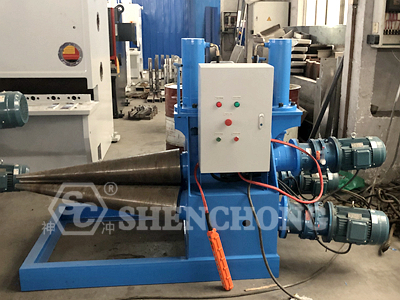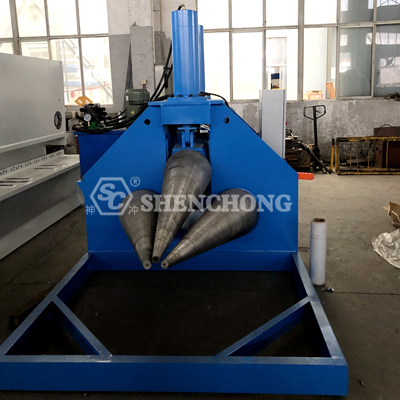
This equipment is a cone three-roller plate rolling machine. The three rollers are all conical rollers, the position of the two lower rollers is fixed, the upper roller is hydraulically lifted, and the three rollers are the main driving rollers.
It is specially designed to roll conical workpieces, and it is controlled centrally by the operating handle. It is mainly used to bend a certain thickness of metal plate into a cone at normal temperature, and its working principle is rotary bending deformation.

It is an important part of the plate rolling machine. The roller surface is conical, the material is high-quality forgings, and it is quenched and tempered.
Steel plate welded structure, removing welding stres. At the top of the frame is equipped with an upper roller pressing oil cylinder, the piston rod of the oil cylinder is connected with the bearing seats of the upper roller. The upper roller moves up and down with the oil cylinder.
The three rollers of this machine are all driving rollers, which are composed of main motor, cycloidal pinwheel reducer and so on. It can rotate forward and reverse to provide power for sheet rolling.
The electrical appliances of this machine are all installed in the electrical box, which is operated by the handle, convenient to operate. The main circuit adopts three-phase 380V alternating current. 3 main motors drive the work rolls to rotate, and 1 motor drives the hydraulic pump station with short circuit overcurrent protection.
The three rollers of this machine are all driving rollers, which are composed of three main motors, cycloid reducers, etc. It can rotate forward and reverse to provide power for sheet rolling.
Drive the upper roller to up or down through the hydraulic cylinder.

The feeding of the metal plate is driven by the friction between the metal plate and the work roll. According to the arc formed by the three tangent points between the metal plate and the work roll, the plate is bent into an arc. The required radius of curvature of the arc can be achieved by adjusting the inclination and lifting of the upper roller.
First make the distance between the lower busbar of the upper roller and the upper busbar of the lower roller greater than thickness of the plate, then press well the head of the fan-shaped plate, centered and symmetrically placed on the lower roller, which is the basic working position. Gradually press down the two cylinders (note: the pressure is not synchronous). Operating the rollers rotation(Align the rotation direction with the feed direction). Bend the middle of the sheet according to the radius of curvature. Correspondingly adjust the inclination and lifting of the upper roller. Repeat the forward and reverse rolling several times until the mouth is closed. The position of the upper roller and downward need to be mastered by rich rolling experience.
Raise the upper roller to a certain height, and the rolled workpiece can be unloaded from one end of the upper roller, and the unloading work is completed.
Before cone rolling, we should clean up the sheet oxide slag, and do not make the upper and lower rollers squeeze each other. Excessive pressure will easily cause the rollers to break.
If the fan-shaped plate placed asymmetrically on the roller, it is easy to cause misalignment and wrong sides when closing. Improper adjustment of the upper roller will easily cause the small or large mouth to be connected first. The specific operation requires experience,it is best that experience operators to test and operate machine.
If pre-bent fan-shaped plate not pre-bent, it is necessary to roll two sides of the plate firstly, then roll the central to ensure that both sides of the weld are straight, finally correct it on the cone plate rolling machine after welding.